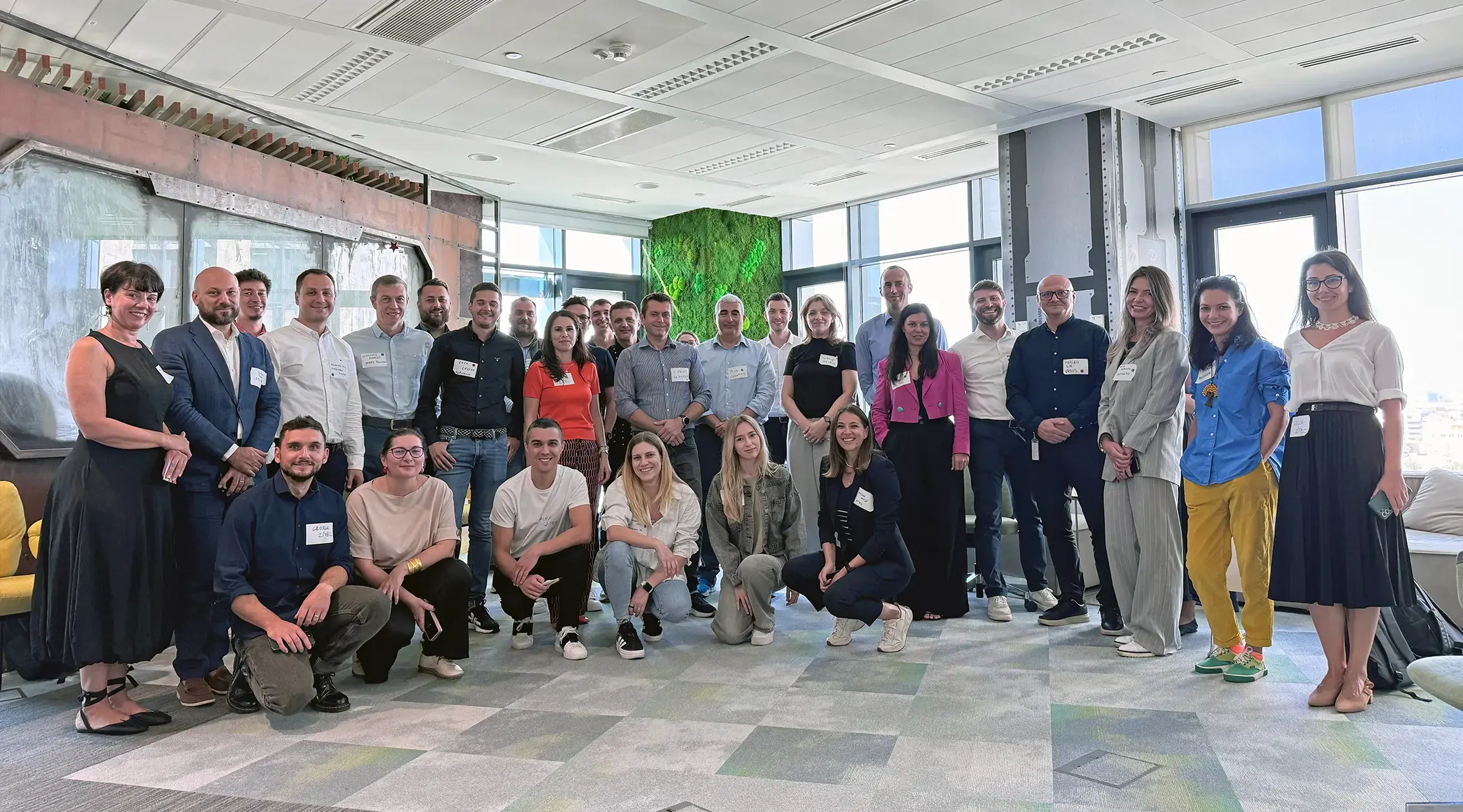As applications of AI become increasingly tangible across various industries, this technology is poised to be the next big market mover. But how can businesses leverage artificial intelligence effectively? In other words, what are the real-life AI use cases? How can we get the most value out of this transformative technology?
And we get it — everyone’s discussing it, but how many have actually taken a step forward and implemented AI to generate value?
While plenty of companies still grapple with integrating AI into their operations, at Zitec, we invested significant time and resources into answering that question. Today, we’re laying it all out for you.
This article will explore how AI can drive real business change, drawing from our proprietary data and on-field experience. We’ll discuss:
- AI use cases — Real-world examples of AI transforming retail, finance, logistics, and other industries.
- Applications of AI — How businesses use AI for fraud detection, data analysis, decision-making, or improving customer experiences and digital transformation adoption
- AI’s business value — How Zitec’s AI-powered pilot solution analyzed over 400,000 notices in record time and reduced repetitive tasks significantly for the Ministry of Environment.
- How artificial intelligence (AI) drives digital transformation, even in traditionally resistant industries.
PS: Don’t miss out on the practical guide on how to effectively integrate AI into your business at the end of our article, developed in collaboration with our data & AI experts.
The Power of AI in Fraud Detection

Source: Zitec internal analysis based on a client project
Traditional fraud detection methods often rely on rule-based systems (e.g., the if/then rule) and historical data, which face significant limitations. They can be slow to adapt and often generate high false positives, requiring manual intervention, such as:
- The lack of scalability
- Being slow to adapt to new types of fraud
- Difficulty in identifying more complex, sophisticated fraudulent activities
- Tending to generate a high number of false positives, which requires manual intervention and analysis
AI, particularly generative AI and machine learning models, offers a solution to these limitations. By analyzing large datasets in real-time, AI systems use pattern recognition to identify anomalies that indicate fraudulent behavior accurately.
Take, for example, our recently developed AI solution for the Ministry of Environment, Water and Forests, which achieved a success rate of around 90% in identifying fraudulent activities.
AI models (both Gen AI and ML) are faster, more accurate, and cheaper than traditional fraud detection methods, and that’s a given.
Challenges in AI-driven fraud detection
Training AI models for fraud detection is not without its challenges:
- A primary issue is the occurrence of false positives, where legitimate activities are incorrectly flagged as fraudulent, especially with the use of generative AI models. For this reason, manual intervention is still very much needed to calibrate these models, even though the accuracy rate is generally high.
- Another challenge is the continuous evolution of fraudulent tactics, which requires frequently updating and iterating AI models. Partnering with IT leaders with the know-how of modeling complex technologies such as artificial intelligence is essential here.
The good news? AI applications in fraud detection can be applied to virtually all industries. How exactly? It starts with assessing your organizational needs, identifying the right AI use case, and developing a discovery & validation plan.
The Use of AI in Data Analytics
AI applications are numerous, including data analytics. This technology has proven effective in analyzing large datasets with remarkable accuracy and lower costs compared to traditional methods.
So, how does AI bring in added value when it comes to leveraging data analytics? Let’s talk specifics.
At its core, artificial intelligence uses advanced algorithms and models, such as machine learning algorithms (ML) and natural language processing (NLP), to sift through and make sense of unstructured data. Unlike structured data (which fits neatly into rows and columns), this data comes in various formats and requires more sophisticated analysis techniques.
For instance:
- In image processing, AI models, such as machine learning, Gen AI, Predictive AI, and more, can detect patterns, anomalies, and specific objects within large sets of images. These capabilities are powered by convolutional neural networks (CNNs), a deep learning model that excels at recognizing visual patterns.
- In text processing, NLP allows artificial intelligence to understand context, sentiment, and key themes, transforming raw text into structured insights.
- In audio data processing, AI uses speech-to-text conversion and acoustic analysis to identify patterns in voice recordings or detect fraudulent activity based on tone and content.
Essentially, generative AI leverages ML and can use NLP techniques to perform its functions. However, it focuses more on creation than just processing or analysis.
While higher investments in this technology can lead to greater returns, that's not always the case. All risks need to be carefully balanced and assessed, as some opportunities may offer high rewards, but they also come with higher risks.

Source
Knowing what investments to prioritize (quick wins vs. differentiating use cases vs. transformational initiatives) is also essential in your strategic direction. But given the complex business environment, wouldn’t it be best to know what each entails, specifically for your company? Discovering the fastest path for time-to-value is vital.
AI Applications in Driving Digital Transformation
Digital transformation is a multifaceted journey. It involves rethinking business models, modernizing applications, and keeping an eye on customer experiences, all while deploying technologies like AI to automate processes, optimize costs, and drive sustainable innovation.
However, such digital technologies don’t work siloed. They must integrate into all business areas. This fundamentally changes how teams operate and deliver value to customers. But accounting for factors like:
- In-house processes
- The organziational culture
- The evolving demands of the market
- Stakeholder buy-in and board consensus
Is already proving to be a huge challenge for businesses.
Hence, in their quest to drive digital transformation, competitive companies turn to the proven approach of adopting:
- Cloud infrastructure – The backbone of digital transformation, cloud computing provides the scalability, flexibility, and cost-efficiency needed to support new digital initiatives.
- Application modernization – This involves updating legacy applications to be more agile, efficient, and responsive to current business needs.
- Sustainable innovation – Developing new business models that drive profitability, improve customer experiences, and contribute to environmental and social sustainability.
- Trusted digital transformation partners – The agent and facilitator behind adopting this massive shift. Technology patterns are essential during this transformation, linking technicality, technicity, and teams.
AI’s role in digital transformation
AI applications in digital transformation revolve around automation and cost optimization. It enhances decision-making by analyzing vast amounts of data in real-time, identifying patterns, and providing valuable insights.
While industries like fintech or retail are rapidly adopting AI, sectors traditionally resistant to change are also beginning to see the benefits:
- In forestry, AI can monitor large forest areas for illegal logging in real-time, something previously challenging and less impactful with manual methods (something we’ve already done at Zitec – but more about that below)
- In logistics, AI-driven automation can streamline processes that were once heavily reliant on human resources for intervention. Think of route optimization solutions, predictive equipment and estate management, last-mile delivery apps, and more.
- In retail, we see artificial intelligence in action through custom solutions that drive hyper-personalization to new heights (think of product recommendations, user-based search functions, etc.), improving omnichannel customer experiences, or through custom inventory management solutions.
While the applications of AI are, at their core, similar (improving decision-making, fraud detection, automating routine tasks, growing productivity), the actual use cases across industries have their own set of specifics.
AI Use Cases Across Industries
Source
So far, we’ve explored “the how.” Indeed, the applications of AI in areas such as data analytics, fraud detection, or digital transformation are remarkable.
But what about “the what”? What AI use cases should you know that are specific to different industries? Let’s dive into that.
1. AI in Retail
Source
AI applications in retail include:
- Hyper-personalizing customer experiences
- Improving their omnichannel approach
- Efficientizing their operations
Personalizing customer experiences at scale
Personalization is one of the top priorities for European retailers, as it is proven to generate more value through better conversion rates and higher customer lifetime values. How so? It's relatively simple. AI-driven recommendation engines analyze customer behavior and preferences to deliver highly personalized product suggestions.
This approach enhances the shopping experience and drives sales with predictive models and personalized recommendations.
By implementing machine learning models like Google's Recommendations AI, retailers can better predict customer behaviors, which allows them to offer tailored shopping experiences that boost customer satisfaction and increase repeat purchases.
In fact, during a Zitec roundtable event about AI in retail, one fashion retailer revealed how AI-driven personalization tools led to a significant rise in average order values and customer loyalty.
Optimizing inventory management and demand forecasting
Artificial intelligence is also transforming how retailers manage inventory and forecast demand. Traditional methods can result in either overstocking or stockouts, which are costly and time-consuming.
Walmart, for instance, uses AI to optimize inventory management, reducing errors in demand forecasting and simplifying inventory management in over 4,700 stores.
Similarly, during the same Zitec roundtable event, we witnessed firsthand how Romanian retailers improved supply chain efficiency by analyzing historical sales data and market trends using custom digital solutions. This led to better stock predictions and reduced operational costs.
2. AI in Financial Services
Source
As the financial services industry evolves, artificial intelligence will remain a key driver of innovation and transformation. From fraud detection and customer support to credit scoring, AI helps financial institutions operate more efficiently while delivering better customer experiences. But implementing this technology comes with its own set of challenges for fintechs.
Fraud detection and prevention in BFSI
Traditionally, identifying fraudulent transactions has been a labor-intensive process prone to errors. This results in many false positives, which frustrate customers and financial institutions.
Artificial intelligence, mainly through machine learning algorithms, has made a difference in this space by allowing the real-time analysis of transaction data. As such, this technology helps reduce false positives while improving fraud detection accuracy.
For example, HSBC has deployed an AI-powered machine learning system that analyze data in transaction patterns across 40 million accounts to detect financial crime, resulting in 60% fewer false positives.
"The machine learning models are able to train on data across multiple locations, and analyze transaction flows and other parameters to detect more complex typologies." - Neil Katkov, Director of Celent's global Risk practice.
Essentially, AI-driven fraud detection boosts security and builds customer trust by reducing the likelihood of legitimate transactions being mistakenly flagged.
Customer support

Source
Customer support is another area where AI is making a substantial impact. Financial institutions use AI-powered chatbots and virtual assistants to handle routine customer inquiries. This frees up human agents to tackle more complex issues and improves the customer experience by providing instant support around the clock.
Bank of America’s virtual assistant, Erica – a machine learning-powered solution that uses NLP, is a prime example of how AI transforms customer service. Launched in 2018, Erica has since handled over two billion customer interactions, helping users with tasks ranging from checking account balances to finding past transactions.
But Erica isn’t the only customer support use case in financial services. All major banks are now streamlining such operations using AI-powered technologies, and the trend will only rise. We also expect to see growth in both the range of financial applications of AI and the feature enrichment level added to these solutions. One similar example from the Romanian market is Banca Transilvania, which integrated Open AI Microsoft Azure in its customer service operations, supporting over 4.5 million visits in just nine months.
Improving credit scoring models
Source
Traditional credit scoring models rely on limited data points, excluding individuals with thin credit histories. AI, however, can analyze a broader range of data, including:
- Transaction histories
- Social media behavior
- Smartphone usage pattern
And many other factors that can help create more accurate and inclusive credit scores.
Fintech startups like Upstart, Zest, and FairPlay AI are leading the charge in this area:
- For example, by using AI to assess non-traditional data, Upstart has expanded access to credit for younger consumers and those with limited credit histories.
- Since 2020, Zest AI has helped lenders evaluate over 39 million consumer loan applications, leading to the approval of $250 billion in loans based on its advanced AI models.
3. AI in the Public Sector and Government
Zitec partners with the Ministry of Environment to combat illegal deforestation with AI
Using AI in the public sector isn’t new. Governments worldwide have already used this technology to improve public safety monitoring or transportation planning for traffic management.
Still, the applications of AI haven’t reached full maturity in this sector. In fact, In Romania, one of the most prominent uses of AI for the public good has recently been developed by our teams at Zitec, and it made the news. Let’s explore this AI application in-depth below.
Automating compliance and regulatory processes
Source: Zitec Client Case Study
Artificial intelligence has impacted how the public sector operates by automating compliance and monitoring processes. This helped improve adherence to complex regulations and streamline time-consuming tasks.
Our idea of a public sector AI use case? The AI-powered Romanian public timber transport monitoring solution we developed to combat illegal deforestation which is able to:
- Reduce human error
- Accelerate decision-making and the issuance and collection of fines
- Improve cost-efficiency and minimize the time dedicated to analyzing notices
By automating these processes, government officials can maintain accuracy and efficiency while managing millions of notices almost instantly. The benefits and quick wins from this pilot (soon-to-be a fully-fledged solution) include:
- Automated reporting
- Improved detection of non-compliance patterns
- High accuracy in predicting regulatory breaches for consistently bad actors
This helps reduce the administrative burden on government bodies and ensures that regulations are enforced consistently and fairly to protect Romania's natural resources.
AI drives sustainability
Source: Zitec Client Case Study
Just think of the impact. Even with the pilot version, the solution was able to sift through over 400,000 transportation permits and millions of images to identify patterns of fraudulent activities, such as repeated or anomalous entries.
This has led to huge enforcement actions, like fines totaling 3.84 million RON. An in-depth cost analysis revealed that 125 people would’ve needed to work a whole month to check all notices without this technology, mostly in areas like manually checking notices, which represent repetitive actions with no creative or strategic implications. Hence, the AI algorithms incurred a prospective decrease of 99.9967% in total time spent.
So, how can you effectively integrate AI into your business?
 Every company must follow a structured approach to integrating AI into a business model. This level of disruption doesn’t come overnight. Hence, the first step is to invest in strategic planning and properly assess the level of disruption, the resources needed, and organizational objectives.
Every company must follow a structured approach to integrating AI into a business model. This level of disruption doesn’t come overnight. Hence, the first step is to invest in strategic planning and properly assess the level of disruption, the resources needed, and organizational objectives.
This section outlines actionable strategies to make sure your AI initiatives align with your business goals and deliver tangible results.
Define Clear Business ObjectivesStart by identifying specific problems or opportunities that AI can address within your organization but make sure these objectives align with your broader strategic goals. For example, if your priority is to enhance customer experience, your AI initiatives might focus on personalizing customer interactions or improving service delivery. Setting clear, strategic goals from the outset helps maintain focus and measure success. Assess Organizational ReadinessEvaluate how previous disruptive initiatives were adopted within your organization. If past digital transformation projects were well-received, your team might be more open to AI adoption. Readiness also involves understanding your organizational culture — successful AI integration often happens when employees feel supported and involved. Look at how past changes were managed and focus on creating a supportive environment, perhaps through continuous learning programs. Understand the Basics of AIEnsure your team has a solid understanding of key AI concepts like machine learning, natural language processing, and data analytics. This foundational knowledge helps manage expectations and set realistic goals.PS: Zitec can assist by organizing workshops tailored to your organizational needs, providing your team with the essential insights they need to effectively engage with AI. Evaluate Potential ROIWhen calculating the potential ROI of AI projects, consider both direct benefits, such as cost savings, and indirect benefits, like improved customer satisfaction or increased stakeholder buy-in. Choose the Right AI SolutionsStarting with a Proof of Concept (PoC) to test the potential impact, feasibility, and compatibility of AI models like machine learning vs. Gen AI for a given business use case can be highly beneficial. Testing AI solutions in a controlled environment allows you to validate their effectiveness in addressing your specific business challenges. If the PoC proves successful, it can be scaled into a fully functional digital product that aligns with your long-term business goals. This approach minimizes risk and ensures that the AI solution is viable before full-scale implementation. Communicate and TrainEngage stakeholders across your organization by clearly communicating the benefits of AI. Establish strong relationships with decision-makers, such as CIOs and CTOs, to secure their support. Communication and training can ease the transition and foster a culture of continuous improvement. PS: Zitec offers comprehensive training programs that cover both pre-adoption and post-adoption phases, including continuous integration support and best practices for maintaining AI systems. Establish KPIs and Monitor SuccessSet measurable KPIs to track the success of your AI initiatives. These could include metrics like:
For instance, when implementing AI for predictive maintenance, a manufacturing company will track equipment downtime, defect rates, and maintenance costs. |
Partner with Technology Leaders to Digitally Transform Your Business
As the pace of technological innovation accelerates, adopting AI solutions is no longer just an option but a necessity for businesses that want to stay competitive and drive meaningful change. However, the key to using this technology lies in tailored implementations aligning with your business needs.
Starting with a Proof of Concept (POC) can help businesses:
- Test solutions in a controlled environment
- Assess their impact
- Refine their business approach






.webp)